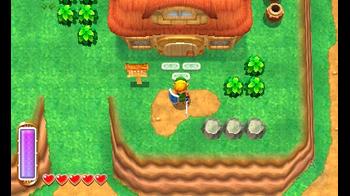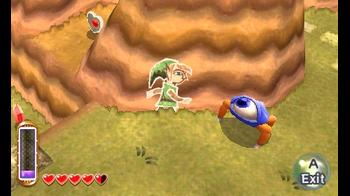
E3 2013: The Legend of Zelda: A Link Between Worlds Hands-On
It’s kind of crazy to think that we’re getting a sequel to A Legend of Zelda: A Link to the Past. It’s one of the greatest games ever made, without doubt, and any sequel has big shoes to step into - so we of course had to check it out during E3 to see how it’s shaping up.
Before we start, some housekeeping: We know that the Zelda games aren’t really proper RPGs. They’re adventure games. We know. However, some of our rival RPG specific sites do cover the series anyway - and when we asked you lot on Twitter if you wanted us to cover them the answer came back as a unanimous yes. So here we are.
Now titled A Legend of Zelda: A Link Between Worlds, the new title of the game tells you one of the key things you need to know - the two world mechanic pioneered with ALTTP’s Light and Dark worlds is making a return here, with Link once again jumping between the two.
The game takes an interesting approach artistically - where Four Swords Adventures, also set in ALTTP’s world, cribbed its art style from Wind Waker, A Link Between Worlds seems to merge the house style of the SNES classic with the minimalist style we’ve seen a lot from Nintendo since Wii Sports.
There’s something vaguely of a Mii about Link’s 3D model in this game, though it also feels a lot like the classic Link, who I think people forget had a markedly different look to the one popularized by Ocarina of Time.
The old-school tunic design is back, as is the slightly darker colouration of Link’s hair. It feels like a sequel to the SNES title, even if Link still cries vocally with the sound-set of the kid Link from Wind Waker.
The visuals aren’t the only things that have a familiar feel about them; there’s many of the same enemies lovingly recreated in 3D for the modern era, and most notable of all is how the main overworld of Hyrule follows the same general layout as the SNES title.
The demo begins outside the very house where ALTTP save games would load you, and the Hyrule Castle soldiers are still hostile across the land as they were then. We know little about the story of the game at this point, but we at least know that something happens to turn Hyrule's Castle guards against Link once again - something beyond Nintendo merely wanting to tug at our nostalgia!
Those left frustrated by the DS entries in the series will be pleased to hear that the touchscreen has been relegated to merely being used for inventory management and maps, as in Ocarina of Time’s 3D upgrade. Link is controlled using the circle pad and buttons, and again, things feel similar to the SNES title this game heavily pulls from.
There’s a speed and snappiness to Link’s movement and combat in this game that feels more satisfying than most other recent efforts in the Zelda series. There’s a speed, simplicity and immediacy to movement that I really appreciate.
One thing has been notably simplified - the way weapons other than your basic sword can be used. Rather than have an arrow or bomb count, for instance, using any special weapon depletes a small meter in the corner of the screen that’s not dissimilar to the typical magic meter. You can never run out of arrows in the typical sense, but spamming them will drain the meter and leave you unable to do anything until it recharges.
The bar does recharge relatively quickly, but this could be used to add an extra layer of difficulty to combat and puzzles. It’s an interesting approach, and one I’m curious to see in action in combat proper.
Link’s big new ability is one that allows him to flatten himself down against walls, turning into a 2D drawing. This can be used to navigate around obstacles that’d otherwise block him, or move about something in 3D space that the top-down view of the game usually wouldn’t allow.
Several times I was stuck on a puzzle, thinking about it in the old Zelda way - and then, remembering this new ability, I found my solution.
The unique 3D effect of the 3DS console doesn’t really come into play until you hit the game’s dungeons. There, if 3D is on, you’ll notice a level of depth not present on the overworld.
Most dungeons in the game are to be constructed in a tower-like fashion to boost the 3D effect - rather than move from room to room, players will be quickly navigating from one floor to another. This, again, is an interesting change - and in this oh-so familiar world is a great place to test it out.
It’d be easy to call A Link Between Worlds lazy, what with its wholesale reuse of the world, concepts and thus far weapons of A Link to the Past. I don’t think that’s fair, though. We already know that the dungeons of the game will be all-new, and we’re still yet to see this game’s ‘Dark World’ - so there’s plenty of ways they can change it up.
Even if it does end up being a bit too samey, it’s incredibly hard to hate on the game - after my brief play session at E3, I was absolutely desperate for more. It’s a class of Zelda we haven’t had for years - and I am so, so ready to play it in full. It’s due out this November.

